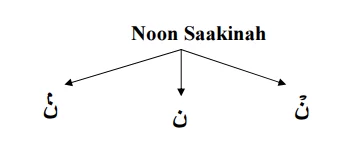Rules of Noon Sakinah are essential for anyone wanting to recite the Quran accurately and concerning its linguistic structure. These rules help pronounce words with the right articulation, flow, and pauses, ensuring the beauty of Quranic recitation is preserved. This article will cover Learn the Tajweed Rules of Noon Sakinah, including Ikhfaa, Idgham, Iqlaab, and Ith-haar. We’ll also provide FAQs at the end for further understanding.
Rules of Noon Sakinah
Rules of Noon Sakinah, Noon Sakinah (ن) is a noon (ن) that appears in the Quran with a Sukoon (no vowel), meaning it has a stable or still sound without any accompanying vowel. Noon Sakinah can appear in the middle or end of a word, and depending on the following letter, how it is pronounced will change according to specific rules.
Rules of Noon Sakinah rules are divided into four categories:
- Ikhfaa (Concealment)
- Idgham (Merging)
- Iqlaab (Changing)
- Ith-haar (Clarification)
Learn the Tajweed Rules of Noon Sakinah, Each rule defines how the Noon Sakinah is treated when followed by specific letters. Let’s explore each in detail.
-
Ikhfaa (Concealment)

- Ikhfaa means to conceal the sound of the Noon Sakinah. In Ikhfaa, the Noon Sakinah sound is softened and almost hidden by blending it with the following letter.
- When to Use Ikhfaa: This rule applies when Noon Sakinah or Tanween (a doubled vowel, represented as two short strokes or damma, kasra, or fathah) is followed by any of the 15 letters: ت ث ج د ذ ز س ش ص ض ط ظ ف ق ك.
- Pronunciation: In Ikhfaa, the tongue does not touch the roof of the mouth fully as it does in Ith-haar (clarification), but instead, a light nasal sound is made. This is why Ikhfaa is also referred to as a nasal or “ghunnah” sound.
- Example: In the word “منزل” (manzil), the “n” sound is softened before the letter ز (za), creating a blend that requires a gentle, nasal pronunciation.
Ikhfaa is a gradual blending and helps in creating a seamless flow of sounds. Practicing Ikhfaa requires mastering the correct amount of nasal sound so that the reader can conceal the Noon Sakinah without it being fully silent.
-
Idgham (Merging)

- Idgham means merging the sound of the Noon Sakinah with the following letter. In Idgham, two letters are merged, causing the Noon sound to blend into the subsequent letter.
- When to Use Idgham: Idgham applies when Noon Sakinah or Tanween is followed by any of the following six letters: ي ر م ل و ن. These six letters are divided into two groups based on whether the merging includes a nasal sound (ghunnah) or not.
Types of Idgham:
- Idgham with Ghunnah (nasalization): When Noon Sakinah is followed by ي، م، ن، و. In this case, the sound is merged with a nasal sound.
- Idgham without Ghunnah (no nasalization): When followed by ل (lam) or ر (ra). Here, the sound merges without any nasal resonance.
Example: In the phrase “من يؤمن” (man yu’min), the “n” sound in “man” merges with the “ya” sound of “yu’min,” creating a smooth transition where the Noon Sakinah sound disappears into the “ya.”
-
Iqlaab (Changing)

- Iqlaab means to change the sound of Noon Sakinah into a different sound, specifically into a meem sound when followed by the letter ب (ba).
- When to Use Iqlaab: This rule applies only when Noon Sakinah or Tanween is followed by the letter ب.
- Pronunciation: In Iqlaab, the Noon sound is transformed into a meem sound with a light nasalization (ghunnah).
- Example: In the phrase “من بعد” (min ba’d), the “n” sound in “min” changes to a “meem” sound, making it sound like “mim ba’d.”
Iqlaab provides a seamless and gentle sound change, which can require some practice as it’s different from the regular pronunciation of Noon Sakinah.
-
Ith-haar (Clarification)

Ith-haar means clarification or making clear. In Ith-haar, the Noon Sakinah sound is pronounced clearly without merging or nasalization.
- When to Use Ith-haar: This rule is applied when Noon Sakinah or Tanween is followed by one of the following six throat letters: ء ه ع ح غ خ.
- Pronunciation: The Noon sound is pronounced distinctly without any merging or nasalization.
- Example: In the word “منع” (mana’a), the Noon sound is pronounced before the letter ع (ayn), maintaining its full and distinct sound.
Ith-haar emphasizes the clear and articulate sound of the Noon, ensuring the recitation is crisp and exact.
How do you memorize Tajweed rules?
Learn the Tajweed Rules of Noon Sakinah, Memorizing Tajweed rules can seem daunting, but breaking it down into systematic steps can make it much more manageable. Here’s a guide to Learn the Tajweed Rules of Noon Sakinah:
1. Understand the Rules in Small Chunks
- Start by dividing Tajweed rules into categories, like Noon Sakinah, Meem Sakinah, Qalqalah, and Madd (elongation). Focus on learning one set of rules at a time to avoid overwhelming yourself.
- Each rule set has its principles and letters associated with it, so studying them separately helps to focus and retain information.
2. Use Mnemonics and Visual Aids
- Mnemonics: For each rule, use a mnemonic to remember key details. For example, the rule Ikhfaa (إخفاء) includes 15 letters. You can create a memorable phrase or a short story where each word begins with one of the letters.
- Flashcards: Write each rule on one side of a card, with its letters and examples on the other side. Reviewing flashcards daily helps reinforce memory.
- Color Coding: Color-code rules in a Tajweed Quran to visually separate rules and aid recall when reciting.
3. Practice Through Repetition and Application
- The best way to remember rules is through application. Choose a Surah that includes various rules and recite them while consciously applying them. Surahs like Al-Baqarah or Al-Kahf contain many examples of different Tajweed rules.
- Repeat verses that include difficult rules multiple times until you can recite them smoothly.
4. Listen to Skilled Reciters
- Listening to Quranic recitation by experienced Qaris (reciters) like Sheikh Al-Husary or Sheikh Al-Afasy can reinforce rule application. Try to follow along with a Tajweed-colored Quran to link sounds with rules.
- Pause and repeat after them to practice pronunciation and flow.
5. Use Mobile Apps and Online Tools
- Apps like Tajweed Quran, Ayat, or Quran Companion have features for Tajweed learning, often including slow recitations, explanations, and rule highlighting.
- Many apps allow you to quiz yourself on Tajweed rules, which strengthens memorization.
6. Recite to a Teacher or Partner for Feedback
- Having a teacher listen to your recitation can provide personalized correction, so you don’t practice mistakes. A teacher can point out areas for improvement or give focused exercises for specific rules.
- If a teacher isn’t available, consider finding a Tajweed study partner. Teaching each other can help reinforce what you’ve learned.
7. Create a Tajweed Journal
- Write down each rule in your own words, with examples and notes on the nuances you find challenging. This personal reference can be helpful for quick review.
8. Daily Review Schedule
- Spend a few minutes each day reviewing one or two rules. Regular short sessions of review are more effective than longer, sporadic ones.
9. Practice with Consistency and Patience
- Tajweed is best learned gradually. Aim for small, consistent goals, such as mastering a rule every week. Celebrate small progress, as it’s a long-term learning process.
With time and consistent practice, Tajweed rules will become a natural part of your recitation, enhancing your connection with the Quran.
Challenges in Rules for Noon Sakinah

in Learn the Tajweed Rules of Noon Sakinah (نُون سَاكِنَة) can indeed be challenging, especially for non-native Arabic speakers or beginners in Quranic recitation. Here’s an outline of typical challenges and some tips to overcome them:
-
Pronunciation
- Challenge: The subtle pronunciation of Noon Sakinah rules, especially when it comes to Ikhfaa (إخفاء) and Iqlab (إقلاب), can be tough. Learners may struggle with producing nasal sounds correctly and differentiating between similar sounds.
-
Memorizing Rules
- Challenge: Memorizing the four primary rules (Idh-har, Idgham, Iqlab, and Ikhfaa) and their specific letters can be confusing. Beginners may struggle to remember when each rule applies based on the letters following Noon Sakinah.
-
Distinguishing Rules in Real Recitation
- Challenge: Recognizing where each rule applies while reciting the Quran can be difficult, as learners often have to pause and think before applying the correct rule.
-
Building Confidence in Recitation
- Challenge: For many learners, fear of making mistakes can create anxiety and hesitation when reciting.
- With regular practice, a good teacher, and the use of resources like Tajweed apps or Quranic study groups, learners can gradually become more comfortable with Noon Sakinah rules and recite with ease.
Conclusion
Learn the Tajweed Rules of Noon Sakinah, Mastering the Tajweed rules for Noon Sakinah brings you closer to the Quran’s linguistic beauty and allows for a respectful recitation of the sacred text. Each rule—Ikhfaa, Idgham, Iqlaab, and Ith-haar—has its unique application that requires understanding and practice. Taking the time to Rules of Noon Sakinah and implement these rules will enhance your recitation and deepen your connection with the Quran.
Whether you’re a beginner or a seasoned reciter, consistent practice, guidance from a teacher, and a love for recitation will make mastering these rules both fulfilling and enriching.
(FAQs)
-
Why is it important to learn the rules of Noon Sakinah?
Learning these rules ensures that Quranic recitation is done as intended, preserving the beauty, rhythm, and linguistic integrity of the Quran. Proper Tajweed also shows respect for the words of Allah.
-
How can I improve my pronunciation for Ikhfaa?
Practice is key. Listen to reciters and try to imitate the nasal sound carefully. Over time, you’ll develop an ear for the right balance in concealment.
-
Can Noon Sakinah rules be self-taught?
While self-study can be helpful, a teacher or mentor is recommended to correct mistakes. Tajweed requires precision, and guidance helps ensure accuracy.


Jaz kumulla